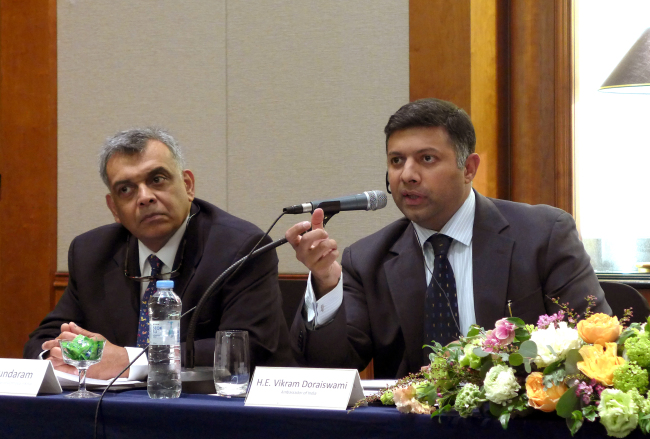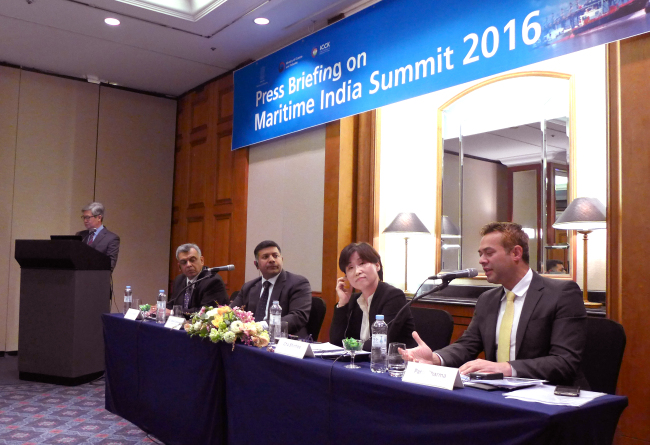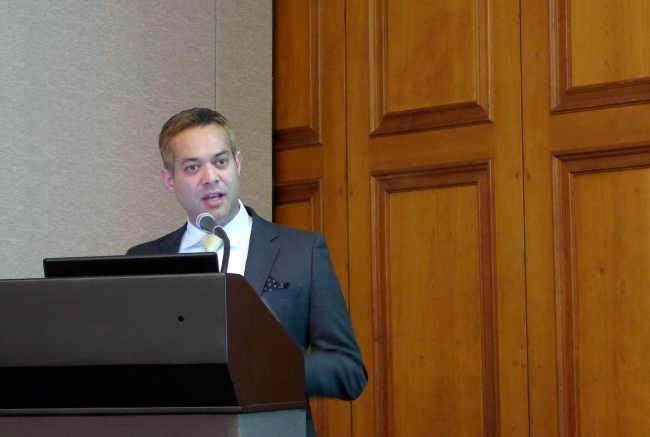India will host the first maritime summit to empower global partnerships and unveil investment opportunities, and Korea is the first single-partner country.
As Asia’s third-largest economy, India has concentrated efforts to industrialize its mammoth capacities, choosing the marine sector as “a means of driving the country’s economic transformation and enhancing connections with the world,” according to Indian Ambassador Vikram Doraiswami.
A maiden undertaking, the Maritime India Summit 2016 will take place at the Bombay Convention and Exhibition Center in Mumbai from Thursday to Saturday.
The event will delve into port-led development, shipbuilding, ship repair and ship recycling, dredging, shipping and logistics, hinterland connectivity, inland water transport, green energy, security, education and training, financing, island development, cruise and lighthouse tourism, marine food and aquaculture.
 |
Indian Ambassador Vikram Doraiswami (right) speaks beside Indian Chamber of Commerce in Korea chairman Dilip Sundaram at a press conference on Thursday on the Maritime India Summit 2016. The event will take place at the Bombay Convention and Exhibition Center in Mumbai from Thursday to Saturday. (Joel Lee / The Korea Herald) |
“Recognizing Korea’s leading capacity in the world in shipbuilding and maritime logistics, Korea became the first partner country for the summit,” Doraiswami said at a press conference on Thursday.
“This was the result of meetings between our Prime Minister Narendra Modi and President Park Geun-hye on the margins of the East Asia Summit in Myanmar in November 2014, and in Seoul in last May, as well as discussions between our foreign ministers in Seoul in December 2014.”
In each of the aforementioned areas, the ambassador noted, foreign investment value would amount to $4 billion up to this year, $8 billion to $16 billion over the next three years and $35 billion in the next five years.
The envoy added that the figures exclude naval, coastal guards and other defense sectors, which make up the bulk of marine construction and shipbuilding in India.
An outcome of a memorandum of understanding in maritime transport and logistics signed between the two leaders last year, the event will gather a Korean delegation of over 50 companies and government branches.
Participating institutions include the Ministry of Oceans and Fisheries, Ministry of Trade, Industry and Energy, Korea Polar Research Institute, Korean Register, Korea Institute of Ocean Science and Technology, Korea Institute of Marine Science and Technology Promotion, Korean Marine Environment Management Corporation and Korea Research Institute of Ships and Ocean Engineering.
 |
(From left on the table) Indian Chamber of Commerce in Korea chairman Dilip Sundaram, Indian Ambassador Vikram Doraiswami, director general of the overseas fisheries and international policy bureau at the Ministry of Oceans and Fisheries Cho Shin-hee and vice chairman of the Indian Chamber of Commerce in Korea Parth Sharma. (Joel Lee / The Korea Herald) |
Cho Shin-hee, director general of the overseas fisheries and international policy bureau at the Ministry of Oceans and Fisheries, said that various political and policy agreements have been borne over the years, following state visits of Park and Modi in 2014 and 2015.
“Politically, our two countries have become much closer through our strategic partnership, and policy wise, the ‘Make in India’ initiative since 2014, which aims to shore up the economy through manufacturing, presents vast markets for Korean companies,” she said.
“To implement the ‘Make in India’ policy, India needs the necessary port facilities and maritime technologies. Korea’s shipbuilding and maritime logistics industries having been in dire straits, the venue will introduce blue oceans.”
India has had a rich heritage of overseas trade with Asia and Africa, using ports of Tamralipta, Poompuhar, Muziris, Kozhikode and Dwarka, noted Parth Sharma, vice chairman of the Indian Chamber of Commerce in Korea. “Rivers were the lifelines of our economy, while ports acted as gateways to India for foreigners and foreign goods.”
The country has over 7,500 kilometers of coastline, across and around which coal, cement, petroleum, oil and lubricants, food grains, steel and fertilizers are transported. Its five inland waterways have a navigable network of 14,500 kilometers, key to hinterland production and relief on road and railway congestion.
Currently, four waterways are being built along the Ganges, Brahmaputra, Mahanadi and Buckingham Canal, and one is in operation between Haldia and Farakka. Through inland waterway development -- worth over $19 billion -- logistics costs would be significantly lowered over the next seven years by over $4 billion, according to the vice chairman.
 |
Vice chairman of the Indian Chamber of Commerce in Korea Parth Sharma (Joel Lee / The Korea Herald) |
“India is looking for a long-term partnership with Korea in the maritime sector, as Korea is a global logistics hub with the world’s fourth-largest throughput at 25 million 20-foot (6 meters) equivalents,” Sharma said. “Korea is a world leader in marine technologies, manufacturing, education and training, with a 30 percent international market share in shipbuilding, ship repair and ship recycling.”
For foreign investors, the government provides various incentives, including a viability gap funding using public private partnership; a 70 percent abatement on service tax for coastal shipping; 10 consecutive years of tax holidays for infrastructure development; exemption on customs and central excise duties; endowment of infrastructure status to shipyards; shipbuilding subsidies; and simplified immigration procedures for cruise shipping.
The flagship “Sagarmala” scheme -- involving over 150 projects worth $19 billion -- targets port modernization, improved hinterland connectivity, coastal community development and port-led industrialization. With a plan to increase cargo from 1 billion of “million tons per annum” to 2.5 billion by 2025, the initiative covers greenfield ports, roads, railways and pipelines, multimodal logistics hub, inland waterways, port-linked clusters and maritime tourism.
“In the last couple of years, India has initiated 15 to 20 projects annually in port development, which were owned by Dubai, Singapore and Dutch port authorities,” Sharma pointed out. “There are at least 55 ships under construction in India right now, but Korea has been absent.”
India has some 1,200 commercial ships, 40 percent of which are over 20 years old, compared to the average life span of 26 years. For upgrading or repair, most ships go to Colombo, Sri Lanka or Singapore.
In shipbuilding, over 95 percent of production is naval, and less than 5 percent is commercial in India, which is the opposite of Korea. While explaining that most components in shipbuilding are the same, except weapons and military-related hardware, Doraiswami said: “In the defense industry, we want Korea to increase our scale of manufacturing in vessel components. The entire logistics chain in Korea, which is so efficient, will meet huge opportunities in India.”
By Joel Lee (
joel@heraldcorp.com)










